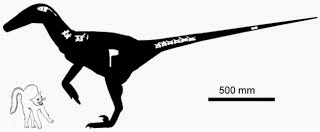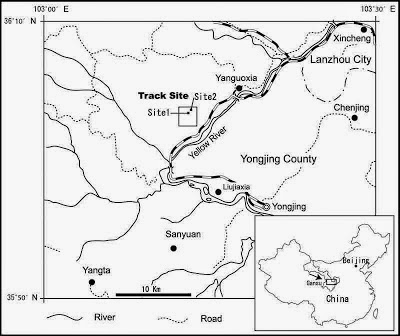The Dromaeosaurid (a type of small Theropod Dinosaur closely related
to Birds and Troodontids) Saurornitholestes langstoni
was first described from the Late Cretaceous Judith River Formation in Dinosaur
Provincial Park in Alberta in 1978, and has subsequently also been found in the
Two Medicine Formation of northwestern Montana. In 2000 a frontal bone (part of the skull) from
the De-na-zin Member of the Kirtland Formation from the Late Cretaceous ofthe
San Juan Basin in New Mexico was assigned to Saurornitholestes langstoni (the frontal bones of Theropod Dinosaurs
are considered to be highly distinctive, and can often be assigned to species
level). In 2006 a second frontal was found in the De-na-zin Member, and
described as a second species of Saurornitholestes,
Saurornitholestes robustus. However
subsequent studies have called into doubt the validity of Saurornitholestes robustus, and suggested that it cannot be
confidently assigned to species or even genus level due to poor preservation,
and may not even be a Dromaeosaurid.
In a paper published in the New Mexico Museum of Natural History andScience Bulletin in 2015, Stephen Jasinski of the Section of Paleontology and
Geology at the State Museum of Pennsylvania, the Department of Earth and Environmental Science at the University of Pennsylvania and the DonSundquist Center of Excellence in Paleontology, re-examines the original New
Mexico Saurornitholestes specimen and
concludes that while it does belong in the same genus as the Canadian material
it does not belong to the same species.
Jasinski redescribes the specimen as Saurornitholeste ssullivani, in honour of palaeontologist RobertSullivan, who discovered the specimen, for his work on the Late Cretaceous
deposits of New Mexico. The frontal of Saurornitholestes sullivani
is similar to Saurornitholestes langstoni in
being triangular and lacking a basin between the median suture and the orbital
rim (a feature seen in the closely related Bambiraptor),
and having a well-rounded, slightly inflated posterior, lacking a frontoparietal
crest. However it differs from Saurornitholestes langstoni in
being constricted at its anterior end, having less prominent nasal sutures, and
a less prominent anterior projection between the nasal and lacrimal facets,
having a deeper but less strongly demarked orbital rim, having a more
pronounces and longer ventrally-directed ridge between the olfactory bulb
surface and the cerebral hemisphere surface, having a smaller and more robust
frontal-frontal suture, and generally being smaller and more robust. Saurornitholestes sullivani is also
slightly younger than Saurornitholestes langstoni,
being 73 million years old, or possibly a little younger, while Saurornitholestes langstoni is dated to
around 75 million years ago.
Saurornitholestessullivani (SMP VP-1270, holotype), nearly complete left frontal; photographs
to the left and illustrations to the right.(A) dorsal view; (B) ventral view; (C)
medial view; (D) anterior view; (E) left lateral view; and (F) posterior view. (A)and(B)
anterior is up; (C) anterior to right; and (E) anterior to left. Abbreviations:
ch, cerebral hemisphere surface; cs, convex surface between olfactory bulb
surface and cerebral hemisphere surface; laf, lacrimal facet; naf, nasal facet;
nf , nutrient foramen (or foramina); obs, olfactory bulb surface; or, orbital
rim ; pop, postorbital process (peduncle); pp , parietal process (peduncle);
and sas, sagittal articular surface. Scale Bar is 1 cm. Jasinski (2015).
Jasinski also notes that an isolated tooth and an incomplete left
second pedal ungula were also referred to ‘Saurornitholestes robustus’.
However these were not collected with the specimen and are not in themselves
considered diagnostic. A survey of isolated teeth from the Kirtland Formation
of New Mexico suggests that more than one Dromaeosaurid species was present in
the area at the time, so these specimens should not be assigned to any
particular species.
See also…
In December 2000 Xing Xu, Zonghe Zhou and Xioalin Wang of the Institute of Vertebrate Paleontologyand Paleoanthropology of the Chinese Academy of...
 New species of Dromaeosaur from the Early Cretaceous of Utah. Dromaeosaurs were small Therapod Dinosaurs, thought to have been the
group most closely related to...
New species of Dromaeosaur from the Early Cretaceous of Utah. Dromaeosaurs were small Therapod Dinosaurs, thought to have been the
group most closely related to... Dinosaur footprints from the Early Cretaceous of Ganzu Province, China. The Deinonychosaurs are the group of dinosaurs most closely related to
the birds. They are divided into two groups, the Dromaeosaurs (popularly
known as 'Raptors') and the Troodontids, which share a common hindlimb
morphology, with two digits used to support...
Dinosaur footprints from the Early Cretaceous of Ganzu Province, China. The Deinonychosaurs are the group of dinosaurs most closely related to
the birds. They are divided into two groups, the Dromaeosaurs (popularly
known as 'Raptors') and the Troodontids, which share a common hindlimb
morphology, with two digits used to support...
Follow Sciency Thoughts on Facebook.


